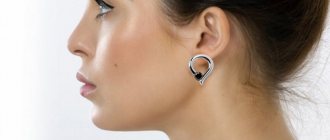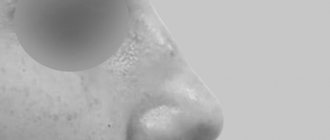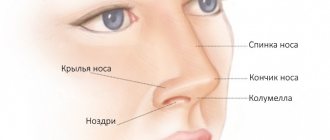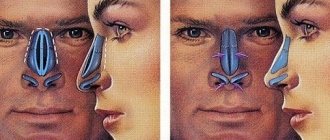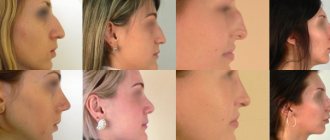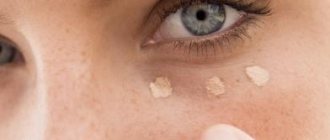Deviation of the nose is a condition in which all or part of the nose is displaced to the side.
This disorder is best seen in the full-face position, that is, when the person is looking directly at you. There are many options for nasal curvature: horizontal or vertical, complete or partial, in the anterior and posterior regions. But in the vast majority of cases, either the tip of the nose or its back deviates from the midline of the face. The latter may also look like a bend in the middle area.
Methods for correcting the shape of the nose
Plastic surgery that helps correct imperfections in the appearance of the nose is called rhinoplasty. By doing this you can fix:
- ● snub nose;
- ● length;
- ● humps;
- ● ugly tip;
- ● curved septum and other defects.
Surgical intervention, which allows both to straighten the nose after a fracture and to eliminate congenital defects, can be:
- ● open when the cuts occur on the outside. Used if significant correction is required;
- ● closed. In this case, the surgeon cuts the nose from the inside. Typically used for less serious surgeries.
The procedure is performed under general anesthesia and takes on average one or two hours. The recovery period lasts approximately six months to a year. Only after this time will the nose take the desired shape.
Types of rhinoplasty:
- ● primary – carried out for the first time, often there are medical indications for it (for example, difficulty breathing);
- ● corrective – performed after the first operation if the nose does not heal exactly as the patient wishes. It takes about half an hour and requires only local anesthesia;
- ● secondary – a more complex event, which is aimed at correcting the results of a poorly performed first rhinoplasty. Unfavorable rehabilitation is also an indication.
A separate method is contour. It is carried out by introducing fillers and allows you to correct minor imperfections: slight asymmetry, smooth out the tip, etc. It is not possible to straighten the nasal septum without surgery.
If you are interested in how to correct the shape of the olfactory organ, contact qualified doctors at VIP Clinic. We will conduct a full diagnosis, determining whether the defect is purely cosmetic or has an impact on health. Depending on this, an individual scheme is selected, which can combine various methods.
Exercises to make your nose smaller
The author of the Facebuilding technique, cosmetologist Carol Maggio and dozens of her followers claim that regular exercise can not only get rid of wrinkles, but also improve your profile.
The nose is part of the respiratory system, formed by cartilage on the outside. Only the bridge of the nose is made of bone. There, in the area where glasses are put on, muscles are placed. The tip of the nose and wings are cartilaginous tissue.
Proponents of face-building claim that the muscles of the nose can be pumped up, the ligaments can be tightened or shortened without surgery. And they even give examples in photographs “before” and “after” of using “nasal gymnastics”.
Adherents of nose gymnastics promise first results after 3 months of regular exercises. For a more pronounced effect, perform the complex in the evening while standing or sitting, without being distracted by other things.
Important: The creators of non-surgical rhinoplasty exercises remind you that a hump or curvature of the back cannot be removed with the help of facial gymnastics. Only a plastic surgeon can remove the growth of cartilage or bone tissue during rhinoplasty.
Reduction and elevation of the tip of the nose
Place your index finger and thumb around your nostrils and tip of your nose, lifting it up. Slowly pull your upper lip down, feeling tension and stretching. Do 40 reps.
Reduction of the wings of the nose
A woman's dream is a narrow, graceful nose with small wings. The Facebook building course promises to narrow your profile. To do this, you need to perform one exercise in the evening. Use your thumb and forefinger to tightly clasp your nostrils and pinch them shut. Do not unclench your fingers, make circular movements, as if rubbing your wings. Repeat the movements 45 times up and down.
Exercises to shorten the nose
If you pump the muscle of the upper lip and the area from the edge of the nostril to the mucous membrane of the lips, you can really get a more graceful nose. To do this, pinch the bridge of your nose with your index finger and thumb. With your other index finger, press the tip of your nose, fixing it. Then lower your upper lip down. Return it to its original position. When performing the exercise correctly, a person feels a flow of blood and a slight tingling sensation in the area of the tip of the nose. For the effect, it is necessary to repeat the complex 40 times within 3 months.
Straightening
Lip manipulation promises to straighten the tip of the nose. To do this, leave your index finger and thumb on the bridge of your nose. The tip of the nose is directed with the fingers of the other hand in the direction opposite to the curvature. At the same time, pull your lower lip down. Stay in this position for 2 seconds. Repeat the movements 40 times.
Narrowing the nose with exercises
The nose is an organ that grows throughout your life. Therefore, with age, the wings grow and the profile loses its sophistication. A simple exercise promises to return to a more youthful and graceful shape without surgery:
- Use your index finger to press on the tip of your nose, pressing slightly upward.
- open your mouth slightly. At the same time, pull your upper lip towards your teeth, as if wrapping them with your lip. When performed correctly, you should feel a slight stretch.
Perform the exercise 40 times. With careful study, Carol Maggio promises that not only the nose will become thinner and more graceful, but also nasolabial wrinkles will disappear and the corner of the mouth will soften.
Exercises for a smooth transition of the nose to the cheeks
With age, many people develop a sharp furrow that runs from the inner corner of the eyes to the nose. This exercise promises to soften this transition:
- Place your index fingers on the inner corners of your eyes;
- Place the middle and ring ones on the side of the bridge of the nose. Wrinkle your nose tightly with your fingers. At the same time, slide your fingers slowly down, reaching the tip of the nose on the sixth count.
Repeat all over again, and so on 20 times.
Nose strengthening
The most static exercise in the complex. On the bridge of the nose, where the muscles of the nose are located, place the tips of your index fingers so that they touch. Slowly press the skin with them, slightly pulling it down.
Reducing your nose with potatoes
Place the tip of your index finger on the tip of your nose, lifting it up. Next, stretch your upper lip, trying to tuck it under your front teeth as much as possible. For a pronounced effect, do 30 repetitions.
Fans of Facebook building claim that it is gymnastics that reduces the size of the nose without surgery. Opponents state that all pressure stretches the skin, contributing to the early appearance of wrinkles on the face, without affecting the cartilage tissue in any way.
Do a face-building routine every day or mask the tip of your nose with concealers—it’s up to you. In any case, we advise you to make an appointment with a plastic surgeon if you are concerned about the shape of your nose. Indeed, in addition to aesthetic discomfort, there may be cysts or a deviated septum that interfere with normal breathing. And no amount of gymnastics or makeup can fix this.
Recovery after rhinoplasty
The period of complete recovery after rhinoplasty is divided into the following stages:
- ● primary, immediately after surgery;
- ● wearing a splint;
- ● disappearance of edema;
- ● final healing.
These stages of recovery may take six months to a year, but the nose and face acquire an attractive appearance within one to two weeks after the operation.
Recovery after rhinoplasty requires the patient to wear a plaster splint for about a week. For another two to three months after the operation, it is forbidden to wear glasses, play sports or undergo physical activity, or go to the sauna or bathhouse. In the first weeks of rehabilitation, there may be a feeling of nasal congestion and discomfort. Pain, as a rule, may be present in the first days; it is mild and passes quickly.
Cosmetic clay: sorted by color
As described above, clay varies greatly in color, slightly in properties and composition. There are several colors: white, blue, yellow, green, red and black. Let's start in order:
- White clay or kaolin: whitening and smoothing out unevenness. The most easily accessible and famous. White cosmetic clay will help with almost all skin problems: acne, flaking, redness, inflammation, and so on. It is easy to find in many formulations of skin and body care cosmetics. After using white cosmetic clay, sebum production is reduced, excess oily shine is removed, acne dries out and facial wrinkles are smoothed out. Moreover, kaolin can be used as a scrub or peel if you want to gently and gently remove dead skin cells;
- Blue clay: healing and drying. No less popular than white and is considered top due to the presence of many vitamins, minerals and microelements. Especially cadmium and cobalt. It is recommended for those with oily and combination skin types to use blue cosmetic clay for the face - acne and blackheads disappear over time. The complexion is refreshed, the skin becomes smooth, clean and radiant. A big bonus is the stimulation of blood circulation, which helps fight cellulite, stretch marks and inflammation;
- Yellow clay: freshness and tone. It contains sodium and sulfur, so it is perfect for dull and “sad” skin of the face or body - it’s a good oxygen shock. The effect is cumulative, but the first results will be visible after just a few uses - the skin will brighten, glow, look healthy and rested. If you have areas on your body with rough or dead skin (elbows, heels), you can apply yellow clay to them to soften, moisturize and exfoliate. It is also an excellent remedy for regulating foot sweating and eliminating unpleasant odor. You can make foot masks to exfoliate the skin on the heels, remove the stratum corneum and unpleasant odor;
- Green clay: relaxation and calm. The composition includes copper and iron oxide - hence the color. These components help stimulate blood circulation, which leads to a pleasant glow on the skin and gradual rejuvenation. Green cosmetic is recommended for use if you have dermatitis or oily skin (in the first case, be sure to consult your doctor!). It's great to take baths with green clay before bed - very relaxing and calming;
- Red clay: warming and healing. It has this color due to a lot of copper, potassium and iron oxide. The skin is very well saturated with oxygen, blood circulation improves. As a result, the elasticity and firmness of the skin increases. Red clay warms up the skin, so it is good to use red cosmetic clay in the cold season to avoid chapping and dehydration. For dry, sensitive or dehydrated skin, red clay is a real gift. Redness, itching, peeling and dryness disappear in a short period of time if masks are used regularly;
- Black clay: cleansing and protection. In its composition you can find magnesium, manganese, quartz, iron and many, many other benefits. Many of them perfectly cleanse the skin and remove dirt and toxins from it. In addition to them, the use of black cosmetic clay helps smooth cellulite and reduce fat. In many salons and beauty parlors, it is used as an anti-cellulite agent for body wraps, massages and other manipulations to reduce centimeters in girth in various places. In addition to all of the above, subcutaneous and intracellular metabolic processes are accelerated. As a result, the skin is not only nourished and moisturized, but also protected from the harmful effects of the environment.
Rhinoplasty price
Those who have decided to change the shape of their nose, to get rid of problems associated with the incorrect structure of the nasal septum or cosmetic defects, are interested in how much nose surgery costs. The price of surgery in Kaliningrad depends on what drugs are needed for anesthesia and during the rehabilitation period, what treatment regimen is developed for the patient. If a nose job is required, the cost is calculated after research and determining whether the defect is cosmetic or has a negative impact on health.


